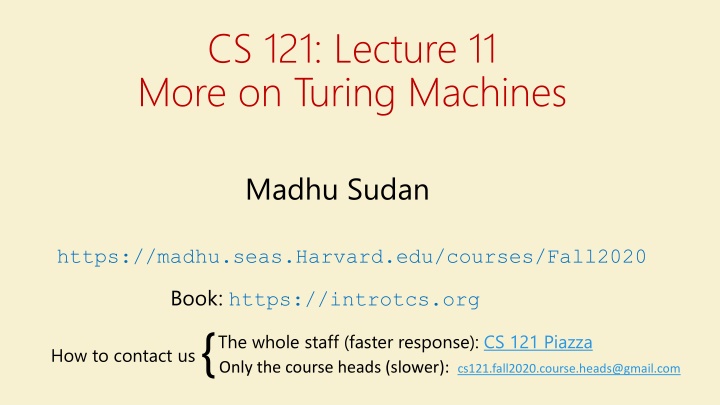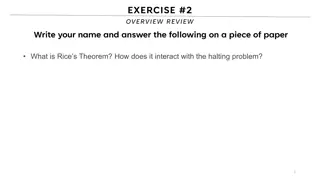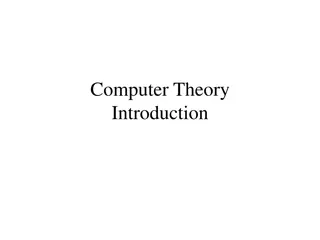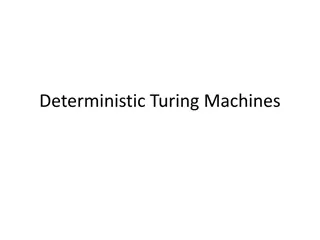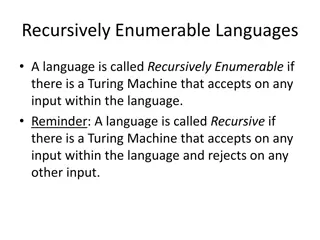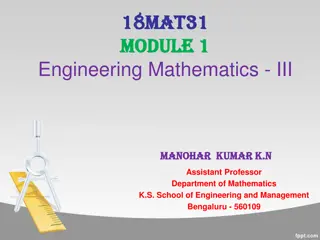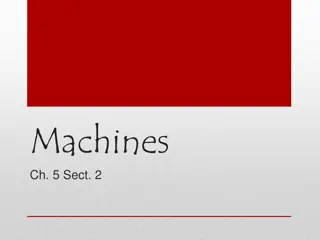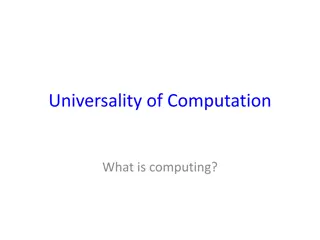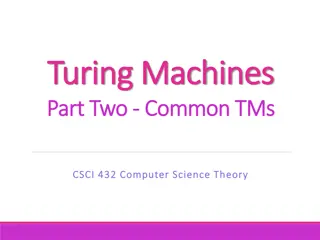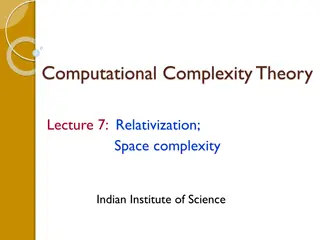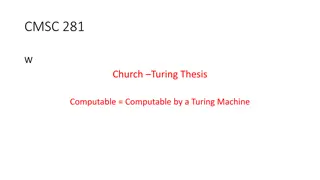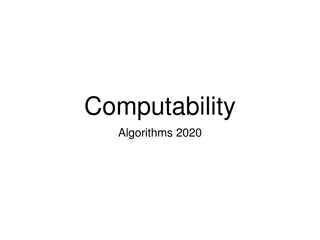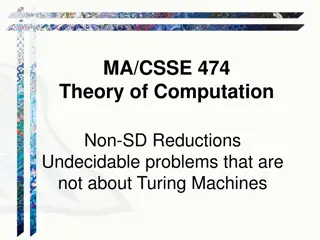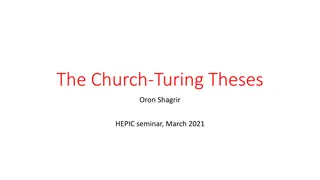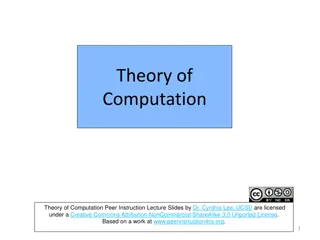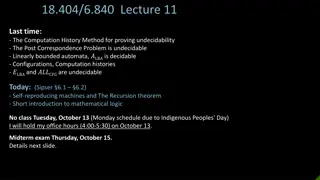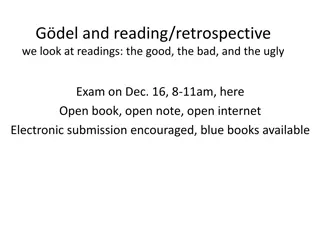Turing Machines: More Examples and Computable Functions
Today's lecture dives deeper into Turing Machines, exploring more examples and discussing computable functions. Topics include recognizing palindromes, computations involving 0s and 1s, and the future of computable functions per Barak's definition. Also covered are the operations, states, and actions of Turing Machines, with practical applications demonstrated through step-by-step processes. Dive into a journey of infinite computation and qualitative studies to expand your understanding of computational theory.
Download Presentation

Please find below an Image/Link to download the presentation.
The content on the website is provided AS IS for your information and personal use only. It may not be sold, licensed, or shared on other websites without obtaining consent from the author.If you encounter any issues during the download, it is possible that the publisher has removed the file from their server.
You are allowed to download the files provided on this website for personal or commercial use, subject to the condition that they are used lawfully. All files are the property of their respective owners.
The content on the website is provided AS IS for your information and personal use only. It may not be sold, licensed, or shared on other websites without obtaining consent from the author.
E N D
Presentation Transcript
CS 121: Lecture 11 More on Turing Machines Madhu Sudan https://madhu.seas.Harvard.edu/courses/Fall2020 Book: https://introtcs.org { The whole staff (faster response): CS 121 Piazza How to contact us Only the course heads (slower): cs121.fall2020.course.heads@gmail.com
Announcements: Advanced Sections: Christina Ilvento on Differential Privacy! Homework 3 due today. Sample midterm available for tech/TeX/rules. Actual Midterm: Pick up on Canvas; TeX your answers ; Submit on Gradescope-submit your answers like a problem set. Section: no video this week; review for midterm. Section on Turing Machines: next week. Midterm review materials: Diego/Joanna s handout Past midterms: two on finite automata without solutions; several from Boaz with solutions.
Where we are: Part I: Circuits: Finite computation, quantitative study Part II: Automata: Infinite restricted computation, quantitative study Part III: Turing Machines: Infinite computation, qualitative study Part IV: Efficient Computation: Infinite computation, quantitative study Part V: Randomized computation: Extending studies to non-classical algorithms
Today: Part 1: More examples of Turing Machines TM to compute ???: 0,1 0,1 where ??? ? = 1 ? = ?? TM to compute : 0,1 0,1 , where ? = ? where ? = ?? and ? ? , ? + 1 Part 2: (Discussion) Looking to the future: Computable functions. Def (7.2 in Barak): Function computable computable by TM Equivalence with other computing & non-computing models: Multiple tapes, RAM, ?-calculus, polynomials
Recall Turing Machines (Barak, Definition 7.1): TM on ? states and alphabet 0,1, ,? is given by ?: ? ? Action, where Action = ?,?,?,? ?=Left, ?=Right, ?=Stay (don t move), ?=Halt (done!!) Operation: Start in state 0, Tape ? = General step: current state ? ; input symbol ?: Let ? ?,? = ?,?,? Write ? on tape (overwriting ?) ; Move to state ?; Move Head left (? ? 1) if ? = ?; right if ? = ?; don t move if ? = ?. Repeat General step until ? = ? ?0 ?? 1??? , Head (?) at ?0
Recognizing Palindromes ???: 0,1 0,1 where ??? ? = 1 ? = ?? Overview/Idea: Scan left to right between #s. Replace extreme symbols by # if they match, Reject if they don t Till middle region is empty.
More details: Alphabet: = 0,1, ,?,# States: 0: Start 1: Scan Right 0 2: Scan Right 1 3: Check 0 4: Check 1 5: Move Left 6: Accept and Halt 7: Reject and Clean Left
Alphabet: = 0,1,,?,# States: 0: Start 1: Scan Right 0 2: Scan Right 1 3: Check 0 4: Check 1 5: Move Left 6: Accept and Halt 7: Reject and Clean Left 0 1 ? # State/Input 0 1 2 3 4 5 6 7
Alphabet: = 0,1,,?,# States: 0: Start 1: Scan Right 0 2: Scan Right 1 3: Check 0 4: Check 1 5: Move Left 6: Accept and Halt 7: Reject and Clean Left
Alphabet: = 0,1,,?,# States: 0: Start 1: Scan Right 0 2: Scan Right 1 3: Check 0 4: Check 1 5: Move Left 6: Accept and Halt 7: Reject and Clean Left 0 1 ? # State/Input 0 invalid (1,#,R) (2,#,R) (6,1,H) (6,1,H) (3,?,L) (3,#,L) 1 invalid (1,0,R) (1,1,R) (4,?,L) (4,#,L) 2 invalid (2,0,R) (2,1,R) 3 invalid (5,#,L) (7,0,L) invalid (6,1,H) 4 invalid (7,0,L) (5,#,L) invalid (6,1,H) 5 invalid (5,0,L) (5,1,L) invalid (0,#,R) 6 invalid - - - - (-, ,H) 7 (7,#,L) (7,#,L) invalid (-,-,H)
Exercise Break 1 Design TM to compute : 0,1 0,1 , where ? = ? where ? = ?? and ? ? , ? + 1 1. Formulate your plan 2. Break from Break (Return from Break + Discuss Plan) 3. Choose your alphabet 4. Set up the states 5. Start thinking about key transitions
One solution: Alphabet: = 0,1, ,?,#,#0,#1 States: 0: Start: Replace ? by #? 1: Zig Right 2. Erase last symbol 3. Zag Left
Alphabet: = 0,1,,?,#,#0,#1 States: 0: Start: Replace ? by #? 1: Zig Right 2. Erase last symbol 3. Zag Left, Replace #? by ?, go to start 0 1 ? # #? #? State/In put (1,#0,R) (1,#0,R) (-,?,H) (-,#,H) 0 invalid invalid invalid (2,?,L) 1 invalid (1,0,R) (1,1,R) (2,#,L) invalid invalid 2 invalid (3,#,L) (3,#,L) invalid invalid (-,0,H) (-,1,H) 3 invalid (3,0,L) (3,1,L) invalid invalid (0,0,R) (0,1,H)
Computable Functions Definition (7.1 in Barak): A function ?: 0,1 0,1 is computable if and only if it is computable by a Turing Machine. Warning: Definition, not a Theorem! Definition: ? = ?: 0,1 0,1 Why ?? ( Recursive ) ? is computable } Turing-Church Thesis: ? is computable by a physical process if and only if it is computable (by a Turing Machine).
In following lectures Turing Equivalence Turing machines can simulate other Turing Machines With multiple tapes With accept/reject states With 1 tape and multiple heads RAM programs: (Main diff: Can read Tape[i] and then Tape[3?+25] in O(1) steps. High-level programs C++, Python Rewrite systems; -Calculus ; Hilbert Problem Universal TMs: TM that takes other TMs as input and runs them! Uncomputability the bane of computing.
